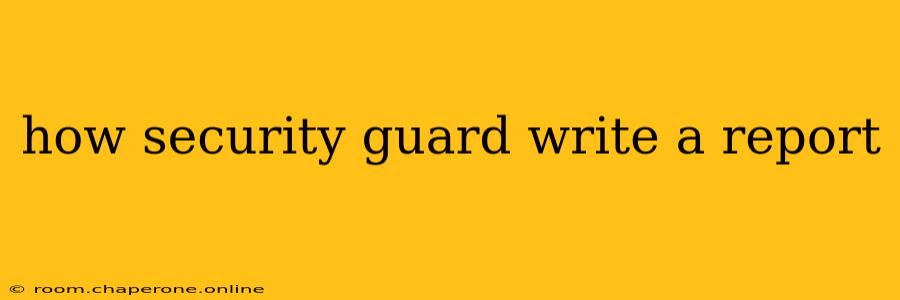How to Write a Professional Security Guard Report: A Comprehensive Guide
Security guard reports are crucial for maintaining order, documenting incidents, and ensuring accountability. A well-written report can be the difference between resolving a situation efficiently and facing legal repercussions. This guide provides a step-by-step approach to writing clear, concise, and effective security guard reports.
Understanding the Importance of Detailed Reporting
Before diving into the specifics, it's crucial to understand why detailed and accurate reporting is paramount. Your reports are legal documents that can be used in investigations, court proceedings, and insurance claims. Inaccurate or incomplete reports can lead to significant consequences for you, your employer, and the individuals involved. Thorough reporting demonstrates professionalism, accountability, and a commitment to maintaining security.
Essential Elements of a Security Guard Report
Every security guard report should include the following key components:
1. Header Information:
- Date and Time: Record the exact date and time the incident occurred. Use a 24-hour clock (military time) for clarity (e.g., 02:30 for 2:30 AM).
- Report Number: Assign a unique report number for easy tracking and retrieval.
- Location: Specify the exact location of the incident, including building name, address, and specific room or area.
- Reporting Officer: Your full name, employee ID, and contact information.
2. Incident Description:
- Objective Account: Stick to the facts. Avoid personal opinions, biases, or assumptions. Describe the incident chronologically, using clear and concise language.
- Who, What, When, Where, Why, How: Answer these six key questions comprehensively. Detail who was involved, what happened, when it occurred, where it took place, why it happened (if known), and how it unfolded.
- Evidence: Note any physical evidence, such as broken property, security camera footage, or witness statements. Include details about the evidence's location and condition.
- Key Details: Include descriptions of individuals involved (height, weight, clothing, distinguishing features), vehicle information (make, model, color, license plate number), and any other relevant details.
3. Actions Taken:
- Immediate Response: Describe the actions you took immediately upon discovering or witnessing the incident. This should include any measures taken to ensure safety and security.
- Follow-up Actions: Detail any subsequent actions taken, such as contacting emergency services, interviewing witnesses, or securing the scene.
- Notification: Specify who you notified about the incident (supervisor, management, law enforcement). Include the time of notification.
4. Conclusion:
- Summary: Briefly summarize the incident and the actions taken.
- Recommendations: Offer any recommendations to prevent similar incidents in the future. This demonstrates proactive thinking and contributes to overall security improvements.
Writing Style and Format
- Clarity and Conciseness: Use simple, straightforward language, avoiding jargon or technical terms unless absolutely necessary.
- Chronological Order: Present the information in a chronological sequence to ensure clarity and readability.
- Professional Tone: Maintain a professional and objective tone throughout the report. Avoid slang, colloquialisms, and emotional language.
- Proofread Carefully: Before submitting the report, thoroughly proofread it for grammatical errors, spelling mistakes, and typos.
Utilizing Technology
Many security companies use digital reporting systems. These systems often include templates, improve efficiency, and ensure consistent formatting. Familiarize yourself with the specific software or platform your company uses.
Example Report Snippet:
Incident Description: At approximately 23:15 hours on October 26, 2023, I observed an individual attempting to force entry into the west entrance of Building A. The individual, a male approximately 6 feet tall with a slim build and wearing a dark hooded jacket, was using a screwdriver to pry at the door lock. I immediately contacted emergency services (911) at 23:17 hours and subsequently apprehended the individual until police arrived at 23:28 hours. The screwdriver was recovered and is currently in evidence.
This guide provides a framework for writing effective security guard reports. Remember, accuracy, detail, and professionalism are crucial. By following these guidelines, you will contribute to a safer and more secure environment and ensure your reports are valuable legal documents.

